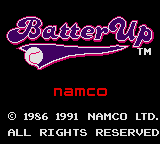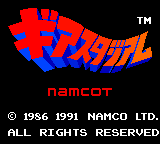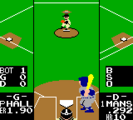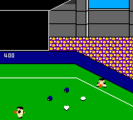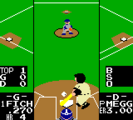Difference between revisions of "Batter Up (Game Gear)"
From Sega Retro
MarioSnicU (talk | contribs) |
|||
| (41 intermediate revisions by 9 users not shown) | |||
| Line 1: | Line 1: | ||
{{Bob | {{Bob | ||
| bobscreen=BatterUp title.png | | bobscreen=BatterUp title.png | ||
| + | | bobscreen2=GearStadium GG JP Title.png | ||
| + | | tab1=US | ||
| + | | tab2=JP | ||
| + | | title=Batter Up | ||
| + | | publisher={{company|[[Namco]]|region=JP}}{{company|[[Namco Hometek]]|region=US}} | ||
| developer=[[Namco]] | | developer=[[Namco]] | ||
| − | |||
| system=[[Sega Game Gear]] | | system=[[Sega Game Gear]] | ||
| − | | | + | | sounddriver= |
| − | | | + | | peripherals=[[Gear-to-Gear Cable]] |
| players=1-2 | | players=1-2 | ||
| − | | | + | | genre=Sports{{ref|https://web.archive.org/web/20130101202427/http://sega.jp/fb/segahard/gg/soft_licensee.html}} |
| − | | releases={{ | + | | subgenre=baseball |
| − | + | | releases={{releasesGG | |
| − | | gg_date_jp=1991-04-05 | + | | gg_date_jp=1991-04-05{{ref|https://web.archive.org/web/20130101202427/http://sega.jp/fb/segahard/gg/soft_licensee.html}} |
| + | | gg_code_jp=T-14037 | ||
| gg_rrp_jp=3,500 | | gg_rrp_jp=3,500 | ||
| − | | | + | | gg_date_us=1991-10{{magref|egm|27|27}} |
| + | | gg_rrp_us=29.95{{magref|gamepro|30|132}} | ||
| + | | gg_code_us=T-14028 | ||
}} | }} | ||
}} | }} | ||
| − | + | '''''Batter Up''''', known as '''''Gear Stadium''''' (ギアスタジアム) in Japan, is a baseball game developed and published by [[Namco]] for the [[Sega Game Gear]]. It is a handheld entry in Namco's ''World Stadium'' series, itself inspired by the earlier ''Family Stadium'' series for the Famicom, whose first entry, ''Pro Yakyuu Family Stadium'', dates back to 1986. | |
| − | '''''Batter Up''''', known as '''''Gear Stadium''''' (ギアスタジアム) in Japan, is a baseball game developed and published by [[Namco]] for the [[Sega Game Gear]]. It has a two-player mode which makes use of the [[Gear-to-Gear Cable]] peripheral. | + | |
| + | Players have a cartoonish, "super deformed" appearance. The game has a two-player mode which makes use of the [[Gear-to-Gear Cable]] peripheral. | ||
An updated version titled ''[[Gear Stadium Heiseiban]]'' (ギアスタジアム平成版) was released in Japan in 1995. | An updated version titled ''[[Gear Stadium Heiseiban]]'' (ギアスタジアム平成版) was released in Japan in 1995. | ||
| − | == | + | ==Gameplay== |
| − | {{ | + | The game follows the rules of baseball. Players choose from 14 fictional "Namco League" teams, each with their own unique players and statistics. Players pick their starting pitchers, the length of the game (5 or 9 innings), and the venue (Park or City). The City stadium has high walls that make hitting home runs more difficult. |
| − | | | + | |
| − | | | + | {{InfoTable|imagewidths=160| |
| − | | | + | {{InfoRow |
| − | | | + | | title=Defense |
| − | | | + | | screenshot=Batter Up, Pitching.png |
| − | | | + | | screenshot2=Batter Up, Fielding.png |
| − | | | + | | desc=When pitching, use {{left}} and {{right}} to position the pitcher on the mound. Throw the ball with {{2}}; use {{left}} and {{right}} for a breaking ball, {{up}} to throw a change-up (slow pitch), or {{down}} to throw a fastball. Faster pitches are harder for the batter to hit but more likely to travel farther or potentially result in a home run. The batter is eliminated when three strikes are thrown; the batter gets a free base if the pitcher throws four balls or a "beanball" (batter hit by pitch). The player can substitute a relief pitcher by pausing the game with {{Start}} and pressing {{2}}. |
| − | + | ||
| − | + | When fielding, the D-pad controls all of the fielders simultaneously (with the camera focused on the one closest to the ball). The player can have the nearest fielder jump or dive toward the ball by pressing {{2}}. Once the ball is in possession, throw it to base by pressing {{2}} while holding a direction corresponding to the base ({{right}} for first, {{up}} for second, {{left}} for third, or {{down}} for home) or press {{2}} by itself to throw to first base. | |
| − | | | + | |
| − | | | + | If the opponent has players on base, the player can press {{1}} while pitching to switch to the fielding view in order to tag out players who might be trying to steal a base. |
| + | }} | ||
| + | {{InfoRow | ||
| + | | title=Offense | ||
| + | | screenshot=Batter Up, Hitting.png | ||
| + | | screenshot2=Batter Up, Running.png | ||
| + | | desc=When hitting, the D-pad positions the batter in the batter's box. Swing with {{2}}; the batter stops the swinging motion when the button is released. The player can bunt the ball by releasing {{2}} mid-swing. While the pitcher is winding up, the player can try to steal a base by holding a direction corresponding to a base and pressing {{1}}. | ||
| + | |||
| + | Runners automatically advance to the next base after the ball is struck; they can be instructed to run to another base by holding a direction corresponding to the base ({{right}} for first, {{up}} for second, {{left}} for third, or {{down}} for home). If they are between bases, they can be ordered to return to the last base with {{2}}. | ||
| + | |||
| + | The player can substitute a pinch hitter by pausing the game with {{Start}} and pressing {{2}}. | ||
| + | |||
| + | Hitters that twirl their bat when approaching the base have extra confidence and are more likely to get a good hit. In the seventh inning, every batter is a prime hitter. | ||
| + | }} | ||
| + | }} | ||
| + | |||
| + | ==Versions== | ||
| + | ===Localised names=== | ||
| + | {{aka | ||
| + | |us_name=Batter Up | ||
| + | |jp_name=ギアスタジアム | ||
| + | |jp_trans=Gear Stadium | ||
| + | }} | ||
| + | |||
| + | ==Magazine articles== | ||
| + | {{mainArticle|{{PAGENAME}}/Magazine articles}} | ||
| + | |||
| + | ==Promotional material== | ||
| + | {{gallery | ||
| + | |{{galleryPrintAd | ||
| + | |sv|6|33 | ||
| + | |egm|27|139 | ||
| + | |gamepro|29|93 | ||
}} | }} | ||
| − | |||
| − | |||
| − | |||
| − | |||
| − | |||
}} | }} | ||
| − | {{ | + | |
| + | ==Physical scans== | ||
| + | {{ratings|GG}} | ||
| + | {{Scanbox | ||
| console=Game Gear | | console=Game Gear | ||
| region=JP | | region=JP | ||
| front=GearStadium GG JP Box Front.jpg | | front=GearStadium GG JP Box Front.jpg | ||
| cart=GearStadium GG JP cart.jpg | | cart=GearStadium GG JP cart.jpg | ||
| + | | manual=BatterUp GG JP Manual.pdf | ||
| square=yes | | square=yes | ||
}} | }} | ||
| + | {{Scanbox | ||
| + | | console=Game Gear | ||
| + | | region=US | ||
| + | | front=BatterUp GG US cover.jpg | ||
| + | | back=BatterUp GG US Box Back.jpg | ||
| + | | spinemissing=yes | ||
| + | | cart=BatterUp GG US cart.jpg | ||
| + | | manual=Batterup gg us manual.pdf | ||
| + | }} | ||
| + | |||
| + | ==Technical information== | ||
| + | ===ROM dump status=== | ||
| + | {{romtable| | ||
| + | {{rom|GG|sha1=10124C1CA517FA933CA0488F288D205B0CC80D9C|md5=681B18412B7861C02C2C7110114A3216|crc32=0E300223|size=128kB|date= |source=Cartridge (JP)|comments=|quality=|prototype=}} | ||
| + | {{rom|GG|sha1=107496F1AFFF8BCEBCD507226E953871FC4D80E4|md5=3190DA5093D53B220BF15229B5299D42|crc32=16448209|size=128kB|date= |source=Cartridge (US/EU)|comments=|quality=|prototype=}} | ||
| + | }} | ||
| + | |||
| + | ==References== | ||
| + | <references/> | ||
| + | |||
| + | {{BatterUpOmni}} | ||
Revision as of 00:19, 23 May 2024
| |||||||||||||||
| Batter Up | |||||||||||||||
|---|---|---|---|---|---|---|---|---|---|---|---|---|---|---|---|
| System(s): Sega Game Gear | |||||||||||||||
| Publisher: Namco (JP) Namco Hometek (US) | |||||||||||||||
| Developer: Namco | |||||||||||||||
| Peripherals supported: Gear-to-Gear Cable | |||||||||||||||
| Genre: Sports[1] (baseball) | |||||||||||||||
| Number of players: 1-2 | |||||||||||||||
|
Batter Up, known as Gear Stadium (ギアスタジアム) in Japan, is a baseball game developed and published by Namco for the Sega Game Gear. It is a handheld entry in Namco's World Stadium series, itself inspired by the earlier Family Stadium series for the Famicom, whose first entry, Pro Yakyuu Family Stadium, dates back to 1986.
Players have a cartoonish, "super deformed" appearance. The game has a two-player mode which makes use of the Gear-to-Gear Cable peripheral.
An updated version titled Gear Stadium Heiseiban (ギアスタジアム平成版) was released in Japan in 1995.
Contents
Gameplay
The game follows the rules of baseball. Players choose from 14 fictional "Namco League" teams, each with their own unique players and statistics. Players pick their starting pitchers, the length of the game (5 or 9 innings), and the venue (Park or City). The City stadium has high walls that make hitting home runs more difficult.
Versions
Localised names
| Language | Localised Name | English Translation |
|---|---|---|
| English (US) | Batter Up | Batter Up |
| Japanese | ギアスタジアム | Gear Stadium |
Magazine articles
- Main article: Batter Up (Game Gear)/Magazine articles.
Promotional material
also published in:
- Electronic Gaming Monthly (US) #27: "October 1991" (1991-xx-xx)[4]
- GamePro (US) #29: "December 1991" (1991-xx-xx)[5]
Physical scans
| Sega Retro Average | |||||||||||||||||||||||||||||||||||||||||||||||||||||||||||
|---|---|---|---|---|---|---|---|---|---|---|---|---|---|---|---|---|---|---|---|---|---|---|---|---|---|---|---|---|---|---|---|---|---|---|---|---|---|---|---|---|---|---|---|---|---|---|---|---|---|---|---|---|---|---|---|---|---|---|---|
|
| 73 | |
|---|---|
| Based on 11 reviews | |
Technical information
ROM dump status
| System | Hash | Size | Build Date | Source | Comments | |||||||||
|---|---|---|---|---|---|---|---|---|---|---|---|---|---|---|
| ? |
|
128kB | Cartridge (JP) | |||||||||||
| ? |
|
128kB | Cartridge (US/EU) |
References
- ↑ 1.0 1.1 http://sega.jp/fb/segahard/gg/soft_licensee.html (Wayback Machine: 2013-01-01 20:24)
- ↑ Electronic Gaming Monthly, "October 1991" (US; 1991-xx-xx), page 27
- ↑ 3.0 3.1 GamePro, "January 1992" (US; 199x-xx-xx), page 132
- ↑ Electronic Gaming Monthly, "October 1991" (US; 1991-xx-xx), page 139
- ↑ GamePro, "December 1991" (US; 1991-xx-xx), page 93
- ↑ Beep! MegaDrive, "May 1991" (JP; 1991-04-08), page 28
- ↑ Consoles +, "Novembre 1991" (FR; 1991-11-07), page 133
- ↑ Console XS, "June/July 1992" (UK; 1992-04-23), page 147
- ↑ Game Zone, "June 1992" (UK; 1992-05-20), page 72
- ↑ Hippon Super, "May 1991" (JP; 1991-04-04), page 42
- ↑ Joystick, "Juillet/Août 1991" (FR; 1991-0x-xx), page 172
- ↑ Sega Power, "December 1991" (UK; 1991-10-30), page 43
- ↑ Sega Pro, "Christmas 1991" (UK; 1991-12-12), page 71
- ↑ Sega Pro, "April 1993" (UK; 1993-03-11), page 74
- ↑ Sega Saturn Magazine, "September 1995" (JP; 1995-08-08), page 88
| Batter Up (Game Gear) | |
|---|---|
|
Main page | Hidden content | Magazine articles | Reception | |
